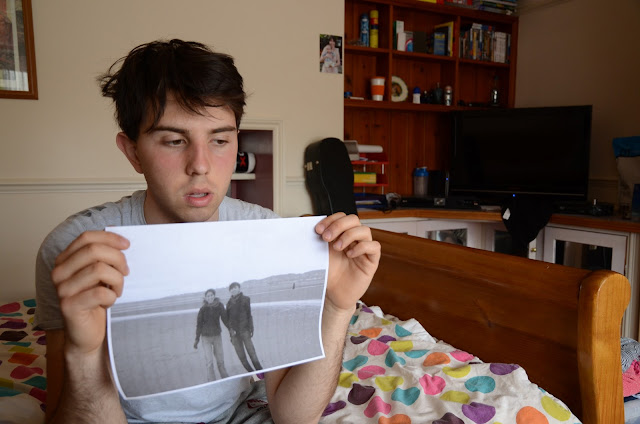The following are some of my favourite unedited photo's which I shot in RAW, on a Nikon D7000:
I like how in a lot of these photo's my boyfriend doesn't make eye contact with the camera. It shows that he is really deep in thought with regards the memory of a bad point in his life, in which he lost a lot of weight due to depression, and became anemic. The fact that his photograph is a black and white print-out reflects the fact that he didn't even have a physical copy of this photograph as it was such a distressing time of his life that bought back bad memories. Although not outwardly sad, it is possible to see little nuances of emotion in his face. As I have mentioned, I now aim to use two photographs of each of my subjects. One as a close-up and one that is contextualised amongst their personal sphere. In this sense I feel this photograph is lacking as the context-based elements are somewhat cut out as it stands somewhere between a closeup and a midshot.
I like this photograph as a close-up in terms of emotion. My boyfriend looks uncomfortable about answering my question and nervously scratches his head whilst looking downwards.
I like this shot again as my boyfriend shields his face and looks rather uncomfortable. Clearly I underexposed the photograph, but this can be fixed easily in cameraRAW edit. Again, I wish I had taken it slightly further back to include the photographs beyond. The reason why I feel this is important is because it serves to support his story. His sister looks over him on the right hand side (the same one who is in the photo) almost like a guardian, and the symbolic Serbian depiction of st. George (my boyfriend is Serbian and his name is Djordje [translated as George in English]) struggles to sleigh the dragon, which represents Djordje's struggles at this point in his life. Djordje believes that this depiction of st. George - which he has had on every wall of every bedroom throughout his life - brings him good luck health wise, as his family was told by a Serbian doctor when he was ill as a baby, that the symbol of st.George would protect him if he kept it near him constantly. This therefore reflects his cultural beliefs and superstitions and is integral to his nature, and so is something that I really want to include in this photograph. This has also given me and idea for the caption of the contextual photograph: Djordje and the dragon.
I like the photo above as Djordje shields his mouth and therefore his expression is hard to decipher. It must communicate based on the viewers assumptions and ideas. I regret not using a tripod in this photoshoot and Djordje's bedroom has many lines, which highlight the apparent wonkiness and level of the camera, however, during a tutorial in class I now know that I can edit the distortion and rotation/horizontal elements of the photo and so should be able to correct these mistakes.
 This is perhaps my favourite photograph of the collection as I really like the expression of Djordje's face mixed with the background elements that serve to make him him. The vivid colours of the duvet and bric a brac in the background contrast with the solemn facial expression and grey tone of the photo/Djordje's clothing. I also think that in terms of positioning this is the best example, as the photograph can be seen clearly and there is a symmetry to the room. The parralel lines of the bed invite the viewers into Djordje's personal sphere. However, the use of the flash in this photograph causes it to be somewhat fluorescent and overexposed and so I will have to correct this in editing.
This is perhaps my favourite photograph of the collection as I really like the expression of Djordje's face mixed with the background elements that serve to make him him. The vivid colours of the duvet and bric a brac in the background contrast with the solemn facial expression and grey tone of the photo/Djordje's clothing. I also think that in terms of positioning this is the best example, as the photograph can be seen clearly and there is a symmetry to the room. The parralel lines of the bed invite the viewers into Djordje's personal sphere. However, the use of the flash in this photograph causes it to be somewhat fluorescent and overexposed and so I will have to correct this in editing.
Overall I am confident that I have some good shots that I can work well with in terms of editing.














